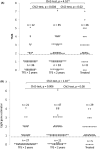A reduced panel of eight genes (ATM, SF3B1, NOTCH1, BIRC3, XPO1, MYD88, TNFAIP3, and TP53) as an estimator of the tumor mutational burden in chronic lymphocytic leukemia
- PMID: 33325634
- PMCID: PMC8451785
- DOI: 10.1111/ijlh.13435
A reduced panel of eight genes (ATM, SF3B1, NOTCH1, BIRC3, XPO1, MYD88, TNFAIP3, and TP53) as an estimator of the tumor mutational burden in chronic lymphocytic leukemia
Abstract
Introduction: Mutational complexity or tumor mutational burden (TMB) influences the course of chronic lymphocytic leukemia (CLL). However, this information is not routinely used because TMB is usually obtained from whole genome or exome, or from large gene panel high-throughput sequencing.
Methods: Here, we used the C-Harrel concordance index to determine the minimum panel of genes for which mutations predict treatment-free survival (TFS) as well as large resequencing panels.
Results: An eight gene estimator was defined encompassing ATM, SF3B1, NOTCH1, BIRC3, XPO1, MYD88, TNFAIP3, and TP53. TMB estimated from either a large panel of genes or the eight gene estimator was increased in treated patients or in those with a short TFS (<2 years), unmutated IGHV gene or with an unfavorable karyotype. Being an independent prognostic parameter, any mutation in the eight gene estimator predicted a shorter TFS better than Binet stage and IGHV mutational status among patients with an apparently non-progressive disease (TFS >6 months). Strikingly, the eight gene estimator was also highly informative for patients with Binet stage A CLL or with a good prognosis karyotype.
Conclusion: These results suggest that the eight gene estimator, that is easily achievable by high-throughput resequencing, brings robust and valuable information that predicts evolution of untreated patients at diagnosis better than any other parameter.
Keywords: chronic lymphocytic leukemia; high-throughput sequencing; prognosis; tumor mutational burden.
© 2020 The Authors. International Journal of Laboratory Hematology published by John Wiley & Sons Ltd.
Conflict of interest statement
The authors have no conflict of interest to declare.
Figures




References
-
- Swerdlow SH. WHO Classification of Tumours of Haematopoietic and Lymphoid Tissues: … Reflects the Views of a Working Group That Convened for an Editorial and Consensus Conference at the International Agency for Research on Cancer (IARC), Lyon, October 25 ‐ 27, 2007. 4th edn. (International Agency for Research on Cancer , ed.). Lyon: Internat. Agency for Research on Cancer; 2008.
-
- Rai KR, Sawitsky A, Cronkite EP, Chanana AD, Levy RN, Pasternack BS. Clinical staging of chronic lymphocytic leukemia. Blood. 1975;46(2):219‐234. - PubMed
-
- Binet JL, Auquier A, Dighiero G, et al. A new prognostic classification of chronic lymphocytic leukemia derived from a multivariate survival analysis. Cancer. 1981;48(1):198‐206. - PubMed
-
- Damle RN, Wasil T, Fais F, et al. Ig V gene mutation status and CD38 expression as novel prognostic indicators in chronic lymphocytic leukemia. Blood. 1999;94(6):1840‐1847. - PubMed
Publication types
MeSH terms
Substances
Grants and funding
LinkOut - more resources
Full Text Sources
Research Materials
Miscellaneous

